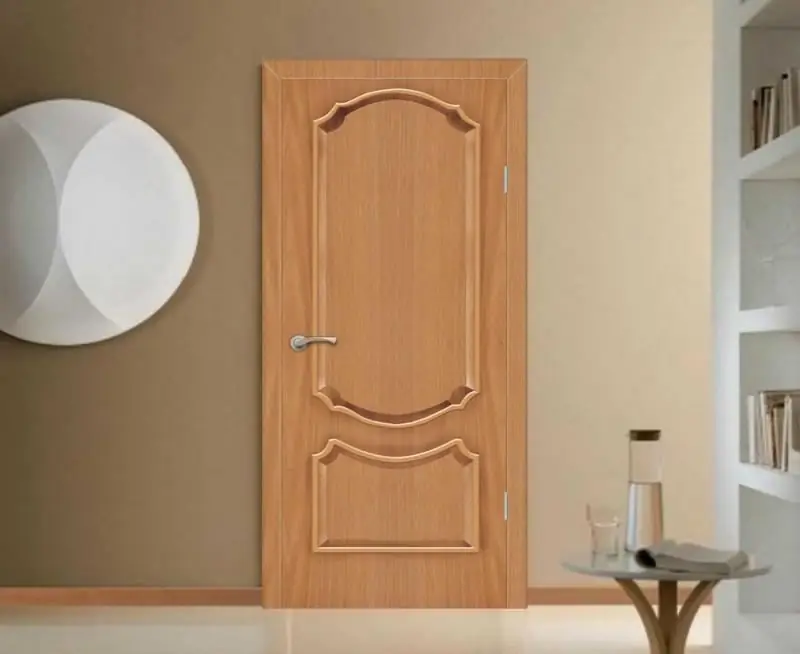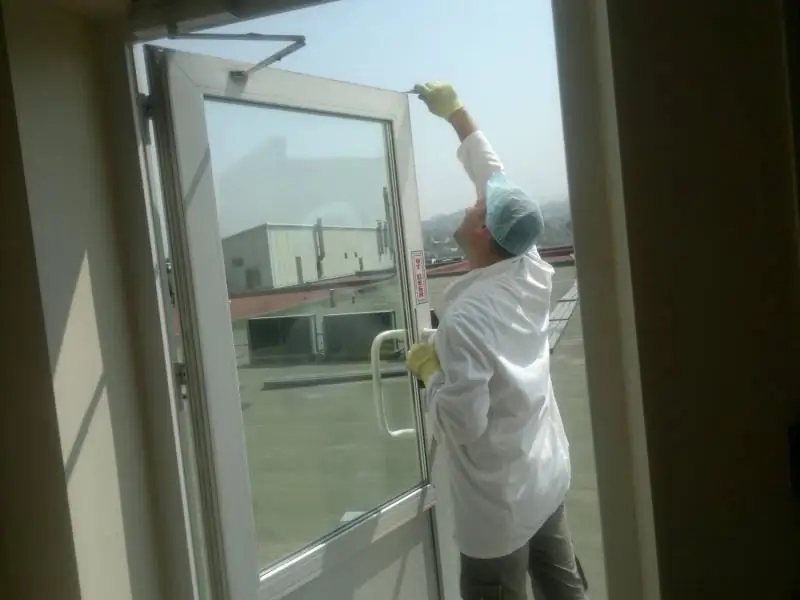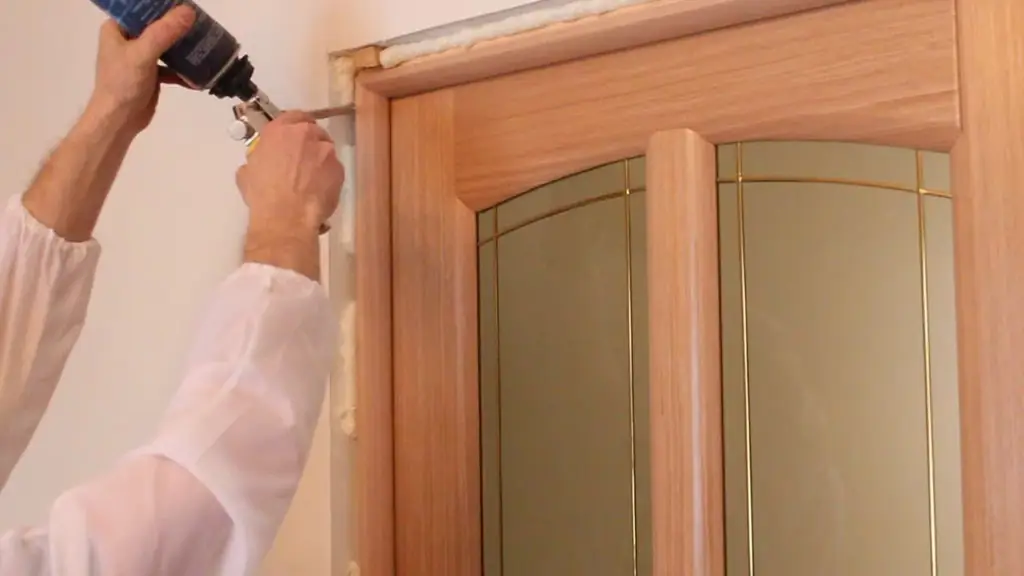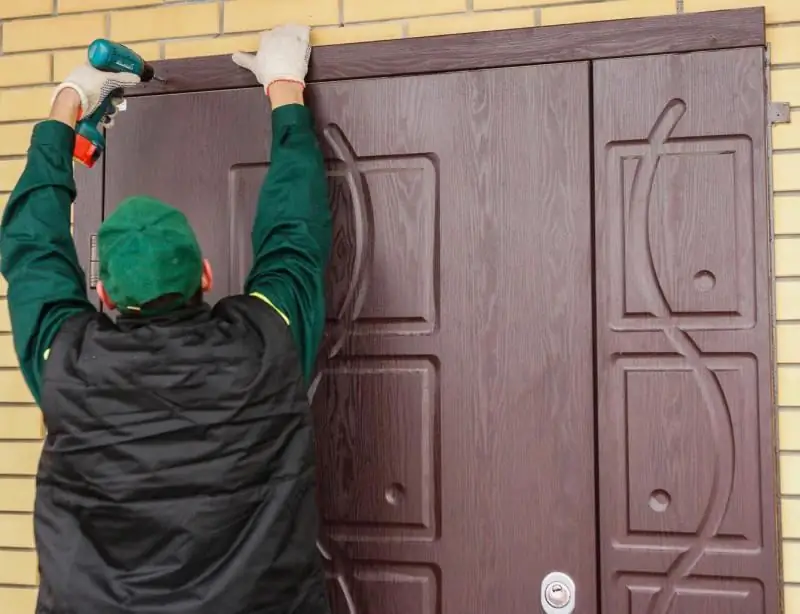
Table of contents:
- Adjustment of plastic doors: an independent solution to all problems
- What is plastic door adjustment
- How to tell if a door needs adjustment
- Is it possible to adjust the plastic door by yourself
- The tool you need to adjust the plastic doors
- Instructions for various types of adjustment
- Is it possible to do without adjusting the door
- Author Bailey Albertson [email protected].
- Public 2024-01-17 22:26.
- Last modified 2025-06-01 07:32.
Adjustment of plastic doors: an independent solution to all problems

Until recently, plastic doors were used only in shopping centers and offices. Later, this element migrated to apartments and private houses, where it took its rightful place in the hallway, hallway and on the balcony. Unlike wood, plastic excludes the penetration of dust and noise, is not afraid of water and is available in various colors. The material is easy to maintain, so it is a reasonable choice. But even a well-made and assembled structure is not a guarantee of durability. Therefore, timely adjustment of the plastic door is of great importance.
Content
-
1 What is the adjustment of a plastic door
- 1.1 Types of adjustment
- 1.2 Reasons for door adjustment
- 2 How to understand that the door needs adjustment
-
3 Is it possible to adjust the plastic door by yourself
- 3.1 The structure of the plastic door
- 3.2 Photo gallery: adjustable plastic door elements
-
4 Tool that you need to adjust the plastic doors
4.1 Table: types and purpose of adjustment tools
-
5 Instructions for various types of adjustment
-
5.1 How to align a sagging door
5.1.1 Video: adjusting a sagging plastic door
- 5.2 How to adjust the height of a plastic door
-
5.3 How to change the pressure of a plastic door
5.3.1 Video: adjusting the pressure of the plastic door
- 5.4 How to replace the seal to improve the pressure
-
5.5 Handle adjustment
5.5.1 Video: Adjusting the Knobs
-
5.6 Setting the correct buttonhole position
5.6.1 Video: Adjusting the Lower Loop
-
5.7 How to adjust the lock on a plastic door
5.7.1 Video: Self-adjusting the Maco balcony latch
- 5.8 Adjusting double-leaf plastic doors
-
- 6 Is it possible to do without adjusting the door
What is plastic door adjustment
Adjustment of a plastic door is understood as the process of checking and bringing its functional characteristics (opening / closing, pressing force) to the required values. Adjustment should be started when you notice the first signs of door malfunction. If the moment is missed, then there is a risk of breakage of the door leaf with the need to replace it, which will require quite significant financial costs. Experts agree that a preventive inspection of a plastic door should be carried out no more than once a year. More frequent repairs are fraught with increased wear of hardware and seal elements.
Adjustment types
The adjustment includes adjusting the position of the door leaf and repairing the door hardware. In the first case, the following types of work are distinguished:
- vertical adjustment designed to eliminate the problem of sagging plastic doors due to their own weight;
- horizontal adjustment, the purpose of which is to eliminate friction between the door and the threshold;
- frontal pressure adjustment, carried out seasonally (summer and winter) to reduce or increase the gap between the leaf and the door frame.

Plastic doors can be adjusted in three directions: vertical, horizontal or frontal
Special attention should be paid to the repair of handles, locks, hinges and other accessories. When the rotary handle has a tight move, it is not so easy to use it, especially if there is a child in the house who cannot physically close the door completely. At the slightest impulse, the sash opens wide. The opposite situation is a loose handle, leading to drafts.
Reasons for adjusting the doors
The reasons for the need for adjustment are several factors.
- Shrinkage of the building. This is a natural process that only occurs in new buildings.
- Incorrect door operation. Hanging foreign objects on the handle and the door leaf, sharp opening and closing of the door increase the load on the hinges.
- Subsidence of the door under its own weight. Although plastic doors are classified as light, no one has yet canceled the force of gravity.
- Sharp and frequent temperature changes. These phenomena lead to depressurization of the door system.
How to tell if a door needs adjustment
An obvious sign that it is time to rebuild a door is cold air and noise seeping into an enclosed space. Problems are also signaled by the difficulty of opening the doors. Finally, a lot of troubles can be caused by condensation that accumulates on the glass or slopes as a result of the formation of gaps between the door and the frame.
For lovers of practical methods, special tricks are offered to assess the condition of the door.
-
Clearance check. For this, a sheet of paper is laid between the ajar sash and the door frame. The door is closed all the way, moving the handle to the lower position. When the sheet is sealed relative to the box, it is very difficult to remove the sheet. If there is a gap between a pair of elements, then the paper can be easily removed.

Checking the gap between the box and the PVC door If the gap is adjusted correctly, the paper will be ejected with noticeable force
-
Skew check. The assessment begins with the fact that the sash perimeter is marked with a pencil on the door frame with the door closed. The edges of the door leaf serve as a ruler. After that, the door is opened and the parallelism of the bottom of the opening and the outlined line is compared. If the parallelism is violated, then the door needs adjustment. A similar comparison can be made using the building level. For this, a level is applied to the horizontal and vertical parts of the open door. The actual misalignment is determined from the deviation of the tool indicators. To determine the skew of the door frame, measurements of its diagonals are made. They must be equal to each other.

Tools for checking door tilt To assess the curvature of a PVC door, a standard bubble level with three flasks, a simple pencil and a three-meter tape measure
-
Checking the immobility of the door leaf in the open state. Open the door slightly to an angle of about 45o and leave it in this position. If the door slams spontaneously or opens even more, then this is a signal for adjustment. Of course, during the test, the influence of wind must be excluded.

Checking the immobility of the blade in the open state If the door, slightly opened at an angle of about 45 degrees, spontaneously opens or closes, it must be adjusted
Is it possible to adjust the plastic door by yourself
With proper installation, the need to adjust the PVC profile door will not come soon. But in the presence of malfunctions, repairs cannot be postponed. If the product is covered by the warranty period, you must contact the company that installed the door. Self-intervention in the structure will remove the door from the warranty. Specialists who have left for the site will eliminate the deficiencies free of charge without damaging the door mechanisms.
It makes sense to adjust the door on your own only after the end of the warranty period. This is a simple matter, you can set up a plastic door yourself, especially since many manufacturers attach instructions to their products with a detailed description of this process. But before starting work, it is necessary to clearly imagine the structure of the plastic door and its main components.

Before you start adjusting PVC doors, always look at the warranty card so as not to violate the rules for using the product
Plastic door device
Any plastic door consists of a base unit and replaceable spare parts, among which there are obligatory (handles, hinges) and optional (lock, closers) fittings. In general, the design of a plastic door can be broken down into the following units:
- frame made of plastic profile;
- PVC door leaf;
- hinges for opening and closing the structure;
- handle for ease of use;
-
lock to ensure the security of the room.

Plastic door device The PVC door can be completed with additional parts that expand functionality - stoppers, sensors, door closers, etc.
Photo gallery: adjustable plastic door elements
-

Swivel pins - With the help of pivot pins, the pressure of the plastic door is adjusted
-

Handles for plastic doors - Handles for plastic doors can be fixed or rotary
-

Hinge device for PVC doors - Hinges are subject to heavy loads, so they are made from metal or Teflon
-

Single and double leaf plastic doors - Plastic doors of any design and degree of complexity lend themselves to adjustment
The tool you need to adjust the plastic doors
To reduce the complexity of the adjustment, a set of necessary tools should be prepared in advance. The minimum standard kit should include the following accessories.
- L-shaped wrenches with a hexagonal cross section. If there are no such items in the home arsenal, then they can be purchased at construction hardware stores. It is better to take several standard sizes - from 1.5 to 5 mm. The estimated cost of the set is 400-500 rubles.
- Flat and Phillips screwdriver. Can be replaced with a screwdriver with suitable bits. The most commonly used nozzles with the marking TX and T.
- Pliers or pliers.

The real lifesaver in door adjustment is the hex key, also called the furniture
If a plastic door has not been used for a long time, then the door hinges may squeak when turning. In this case, machine oil or technical aerosol WD-40 will come to the rescue. They not only remove rust deposits, but also reduce friction in moving machinery. A nozzle in the form of a thin plastic tube is attached to a can of WD-40 grease. Due to its compactness, the product is excellent for door hinges and locks.

WD-40 is available in the form of an aerosol or oil, for doors it is better to use the first option
Table: types and purpose of adjustment tools
| Tool | Appointment |
| Flat and Phillips screwdriver | Tightening the hardware fasteners, dismantling and installing handles |
| Hex keys | Changing the position of the door leaf vertically or horizontally |
| Pliers | Auxiliary tool for disassembling fittings or turning eccentrics |
Instructions for various types of adjustment
Inexperienced craftsmen may decide that adjusting a PVC door is a complex procedure that requires special knowledge. But in practice, you just need to find a mechanism that needs tuning. And the instructions below will help you quickly and efficiently carry out repairs.
How to align a sagging door
It is very easy to recognize a sagging door - its edges cling to the vertical post of the door frame, and when closed, a gap forms on top. Technically, the adjustment of such a door and the resulting misalignment is reduced to changing the gap between the sash and the hinge assembly. The process is similar to that used for adjusting the sashes of plastic windows. To eliminate skewing, use a horizontal adjustment, which allows you to pull the sash to the right or left.
The procedure for adjusting a sagging door will be as follows.
-
Find the horizontal adjustment screw in the lower hinge. It is hidden at the very bottom of the hinge on the side of the frame.

Horizontal adjustment screw on the bottom hinge By turning the screw, you can achieve the displacement of the door leaf towards the door lock
-
We install a hexagon in it and turn it to the right or left. Turning clockwise will bring the sash closer to the hinge, and counterclockwise will move it away.

Horizontal adjustment of the lower hinge to eliminate slack After completing the horizontal adjustment, check the door for free opening and closing.
-
We open the door at an angle of 90 o or more and find a hinge on the top of the sash. Structurally, the mechanism is different from that located below. But it has a similar hole for a hex key. We install the appropriate tool in it and turn it, bringing the door leaf closer or moving away from the axis of rotation. The screws should be rotated until the door stops clinging to the threshold.

Upper hinge horizontal adjustment To eliminate sagging, just turn the key 1-2 times
Video: adjusting a sagging plastic door
How to adjust the height of a plastic door
If there are dents or scuffs on the door seals, then it's time to adjust the sash in height. To do this, pull up the lower loop.
The sequence of actions performed is as follows.
-
We find in the door structure the lower hinge with adjusting screws. Usually they are hidden by a protective and decorative overlay. The latter must be removed by slightly pulling it towards you and up. The plastic dries up and cracks over time, so we do everything very carefully.

Pad covering the bottom loop The decorative strip must be gently pulled towards you and up
-
Removing the cover, we get access to the screw for vertical adjustment. We install a suitable hexagon wrench in its head (in most cases - 4 mm). Turning the key clockwise allows you to raise the blade, and counterclockwise to lower it.

Vertical adjustment to eliminate slack Some manufacturers use a star hole instead of a hex hole
How to change the pressure of a plastic door
It is recommended to adjust the pressure of the plastic door twice a year: decrease in summer to improve ventilation, and increase in winter to save heat in the room. Spontaneous weakening of the pressure in any of the seasons can occur for two reasons:
- wear of sealing gum, which loses its volume over time;
- deformations caused by a temperature gradient.

The use of a high-quality sealant is a guarantee of the tightness of the door structure
The result of the weakening of the clamp is the gaps between the frame and the door itself, leading to a loss of sound insulation and heat. The way out can be to replace the seal, described below, or adjust the corresponding fittings.
Small cylinders located at the end of the sash in the grooves of the plugs act as an adjusting mechanism. They are called eccentrics. One plastic door can have up to seven pressure points. A response mechanism is located opposite the eccentrics. To adjust the pressure density, adjust the eccentrics.
The sequence of actions on adjusting the door pressure consists of several steps.
-
We find all the clamps on the plastic door. They can be located not only on the outside, but also on the inside of the sash and even on top. On their front side there is a hole for a hex wrench, a slot for a screwdriver or a smooth part with flats for gripping with pliers.

Eccentric with hexagon hole The design of the eccentric depends on the manufacturer of the fittings
-
To increase the clamping, the eccentric is turned clockwise, and to loosen it - counterclockwise. The entire set of eccentrics must be in one position, otherwise the door may bend.

The position of the hardware corresponding to a certain pressure The position of the eccentric in the middle of the groove corresponds to the normal clamping
Video: adjusting the pressure of the plastic door
How to replace the seal to improve pressure
If, after turning the eccentrics, a draft is walking around the room, then the seal must be replaced. To do this, a new rubber profile with a cross-section and width similar to the old one is purchased in a hardware store. Good quality is noted for silicone gaskets from Germany, a slightly more budgetary way out is the purchase of ethylene-propylene rubber. To fix the profile, a rubber adhesive is required.
Replacing the seal is reduced to a number of activities.
- The old seal is completely removed, the remains are removed from the groove of the PVC door using a knife.
- The groove for the seal is degreased and covered with an adhesive mass, which is applied with a continuous tape.
- The installation of a new rubber cord starts from the corner, the material is not stretched or compressed when laying.

The seal easily comes out of the groove - just hook the material with a screwdriver and pull it towards you
Handle adjustment
Adjusting the handle is considered the simplest operation to restore a plastic door. In everyday life, two types of handle malfunctions are common: dangling or tight movement. The troubleshooting principle is the same.
-
Rotate the protective insert covering the handle holder 90 o. This allows access to the adjusting screws.

Fastening the door handle to the door The cap that covers the screws is made of plastic, so turn it carefully
-
If the handle is loose, then tighten the opened screws with a screwdriver or screwdriver. If the handle has a tight movement, then loosen the fastener in the same way.

Adjusting the door handles For double-leaf structures, the handles are adjusted in turn
- Replace the protective insert after adjustment. If tightening the screws does not eliminate the play in the connection, then there is a crack in the handle body. In this case, you cannot do without buying new fittings.
Video: adjusting the handles
Setting the correct buttonhole position
Adjustment of the hinges of plastic doors is carried out in two directions: vertically and horizontally. The vertical adjustment is described in the paragraph on setting the door leaf in height. Therefore, we will consider the process of horizontal regulation.
- Open the door and remove the screws from all hinges using a 3 mm Allen key.
- Remove the decorative trims to get close to the adjusting screws.
- Turn the screws on all hinges the same number of turns.

The maximum horizontal adjustment is 2-3 mm
Video: adjusting the bottom hinge
How to adjust the lock on a plastic door
The PVC door is characterized by a multi-layer structure, different from the arrangement of glass or wooden doors. Therefore, locks have their own characteristics and nuances. It is better to entrust the installation of a door lock for a plastic door to professionals, and making a small adjustment is a feasible task for independent implementation. The most widespread for entrance and interior PVC doors are mortise locks, and for balcony doors - latches on rollers.
The plan to restore the lock's functionality depends on the type of mechanism.
-
For mortise locks, the adjustment consists in tightening the screws installed on the main and auxiliary (counter) part of the lock. A suitable tool is a Phillips screwdriver. After tightening, it is necessary to check the lock for the correspondence of its parts to each other. To do this, close the door and make sure that the tongue fits into the groove on the counterpart.

The main and auxiliary parts of the mortise lock The mortise lock for a plastic door has special screws that can be used to adjust it
-
For balcony latches, adjustment is carried out by tightening the screw located above the latch with a 4 mm Allen key. To weaken the clamping of the protruding part of the latch to the counterpart, the key is turned clockwise, to increase the clamping - counterclockwise.

Latch for balcony door To adjust the latch, it is enough to make no more than two turns of the hex head screw
Video: Self-adjusting the Maco balcony latch
youtube.com/watch?v=7_gNyKy8AQc
Adjustment of double-leaf plastic doors
Most of the double-leaf plastic doors are installed at the entrance to the building, and in new houses with improved planning they frame the entrance area of the balcony. A prerequisite for their installation is that the width of the doorway must be at least 90 cm. Structurally, such a door consists of a "leading" and "slave" sash. The first, movable, is equipped with a handle and locking fittings, and the second is fixed and opens when necessary. The shtulp mechanism is responsible for locking and unlocking the "slave" sash.

The stulp is always installed on a passive sash
The adjustment of a door with two leaves does not fundamentally differ from a single-leaf door, except for the adjustment of the faceplate. Adjustment consists of the following steps, depending on the nature of the problem.
- To eliminate the skew of the door leaves, adjust the horizontal and vertical screws in the hinges. To do this, remove the cover from the hinge assembly and tighten the screws with hexagons. The screws located along the axis of the door adjust the height of the leaves. And the hardware, perpendicular to them, brings the sashes closer to each other or to the frame.
-
If the flaps have ceased to snuggle tightly against each other, then it is necessary to examine the shtulp mechanism. Perhaps it is loose and requires adjustment. In this case, use a Phillips screwdriver to tighten the screws that hold the structure.

Adjusting the faceplate screws If the shtulp mechanism is loose, it is necessary to tighten its support bolts
Is it possible to do without adjusting the door
In the experience of many people, the question of adjusting a plastic door comes up when a real problem arises. Can this phenomenon be prevented? Unfortunately, it will not be possible to completely avoid adjustment, but there are several factors that affect its frequency. We will highlight the main ones among them.
- The correct choice of hinges has a significant impact on the sagging of the door. Depending on the weight of the structure, there are hinges designed for a load of 80 kg or 160 kg. The heavier the canvas, the more loops should be. The average value of the loop operation cycle is 200 thousand openings and closings.
-
A reliable way to avoid subsidence of a plastic door is to install a microlift. It consists of a movable strip fixed to the door leaf and a fixed strip mounted on the frame. When the door is closed, both parts engage, slightly raising the door leaf and reducing the load on the hinges.

Microlift for a plastic door The use of a microlift extends the service life of hinges, handles and gaskets
-
The fittings must be lubricated several times a year. For this, in no case should you use improvised means (vegetable oil, petroleum jelly, margarine). It is best to apply mineral, synthetic oil or special compounds for PVC windows and doors to rubbing mechanisms.

Lubrication of plastic door fittings In the case of liquid lubrication, it is enough to pour 2-3 drops of oil into the mechanism
-
Rubber elements provide wind protection. For good pressure, the seal must be cleaned of dirt and coated with a silicone pencil. This keeps the elasticity of the elastic bands.

Seal care The composition of the seal care products must be free of aggressive substances
Installing a plastic door is a simple and effective way to make the room feel cozy, increase noise and heat insulation. But all PVC doors sag over time under their own weight, so they need to be periodically adjusted. If you feel that the door began to open poorly or pass cold air, then you should not panic and call the locksmiths. If the door is not under warranty, then with a careful study of the adjustment instructions, you can independently restore the functionality of this structure.
Recommended:
MDF Doors: Entrance And Interior Doors, Their Varieties With A Description And Characteristics, Advantages And Disadvantages, As Well As Installation And Operation Features

Doors from MDF: features, characteristics, varieties. Making and installing MDF doors with your own hands. Door restoration. Reviews, photos, videos
Do-it-yourself Installation Of Plastic Doors And What Tool Is Required To Carry Out The Work

Methods for installing plastic doors. Required tools and materials. Step-by-step instructions for installing a plastic door. Installation of fittings and slopes
Making Glass Doors, As Well As How To Install Them Correctly And What Tools Are Required To Carry Out The Work

Self-manufacturing technology of glass doors. How to install, adjust, dismantle them correctly. What tools can be used
Do-it-yourself Installation Of Interior Doors, As Well As What Tool Is Required To Carry Out The Work

Types and methods of installing interior doors. The order of work when installing doors. Tools and supplies. Features and nuances of installing fittings
Do-it-yourself Installation Of Entrance Doors, As Well As What Tool Is Required To Carry Out The Work

Do-it-yourself installation of entrance doors. The sequence of work. Checking the correct installation. How to dismantle the front door
